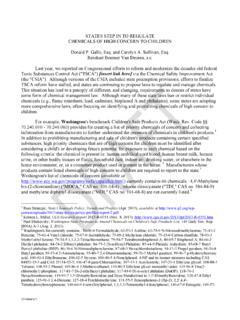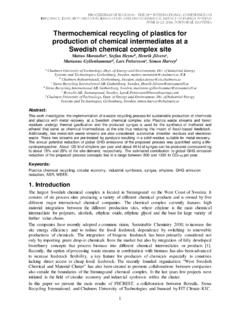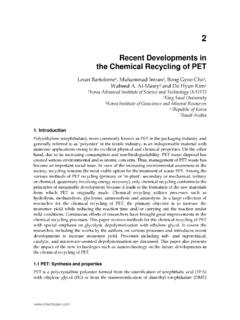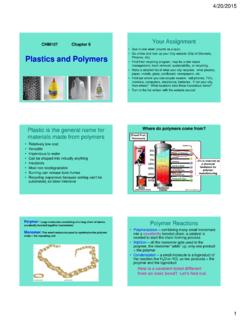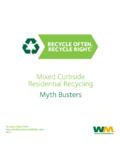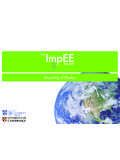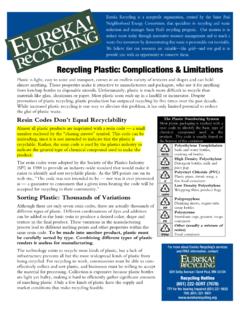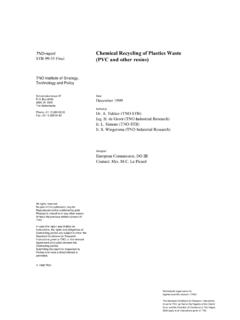Transcription of Processing and recycling polyurethane as thermo and ...
1 Master Thesis CODEN:LUTMDN/(TMMV-5196)/1-77/2005 Processing and recycling polyurethane as thermo and thermosetting plastic Peter Jeppsson 2005 DEPARTMENT OF MECHANICAL ENGINEERING LUND INSTITUTE OF TECHNOLOGY Organization Lund University Document Name Master Thesis Dept. of Production and Materials Engineering 118; S-221 00 Lund; SWEDEN Date of Issue Tel: +46 46 222 45 92; Fax: +46 46 222 45 29 CODEN :LUTMDN/(TMMV-5195)/1-77/2005 Author(s) Peter Jeppsson Sponsoring organization Title and subtitle Processing and recycling polyurethane as thermo and thermosetting plastic Sustainable development to maintain conditions here on earth is today an issue for society and thereby also an issue for everybody. The amount of available raw material is limited; therefore we have to be careful with our natural resources and increase the use of second hand material. The overall description of aims is to examine if it is possible to mechanically material recycle the polyurethane in the tuck wheels and in the escalator handrails.
2 Mechanically material recycle these products necessitate a mechanical process to receive a material that is in a suitable form and size for the restructuring process. Different Processing methods resulted in materials with different structure. The thermoplastic polyurethane (TPU) in the handrail had good mechanical workability provided a small cutting edge angle and large rake face angle. The form of the processed material was less important for the properties of the recycled material. The polyurethane as thermosetting plastic (PUR) had also good mechanical workability provided the same cutting process assumption as for the thermoplastic polyurethane . The form of the processed material and the orientation of it in the press form influenced the properties of the recycled material. It was an advantage to preserve as much of the original structure as possible and orientate it in the direction of the applied force. Attempts to mix the thermoplastic polyurethane and acrylonitrile-butadiene rubber (NBR) rubber were carried out.
3 The thermoplastic polyurethane was assumed to work as a binder and NBR as filler. The result of the recycled blend was a sheet with low properties and without any bonds between the materials. Key Words recycling , Processing , polyurethane , PUR,TPU;NBR Classification system and/or Index term (if any) Supplementary bibliographical information Language English ISSN and key title ISBN Recipient s notes Number of pages 97 Price Security classification Dept. of Production and Materials Engineering 118; S-221 00 Lund; SWEDEN Tel: +46 46 2224592; Fax: +46 46 2224529 I, the undersigned, being the copyright owner of the abstract of the above mentioned dissertation, hereby grant to all reference sources permission to publish and disseminate the abstract of the above mentioned dissertation Signature Date 1 Processing and recycling PUR and TPUP reface This thesis is the presentation of the result of the work carried out at the department of Production and Materials Engineering at the University of Lund.
4 There have been many companies and people helping me on the way by providing all the help I needed in my work with the thesis. Therefor I hereby acknowledge all of you that made it possible for me to finish my Master Degree in Mechanical Engineering. I would like to thank my supervisor Prof. Carl-H kan Andersson and Mats Andersson who gave me all the help during the work and inspiration which was needed to finish this thesis. Christian-Andr Keun at New York Gummiwaren GmbH in Hamburg and Technische Universit t Hamburg-Harburg for material and information about it. Linlan AB and employees there who helped me with some practical work and allowed me to lend their press and electromagnetic heated press tools. Production Manager Sten Axelsson at Stelana AB for material and information about the solid polyurethane wheels. Research Associate Helen Hassander at the Department of Polymer Science & Engineering at University of Lund for lending me stamp and die cutter to make test pieces.
5 PhD Student Toni Reftman at the Department of Mechanical Engineering at University of Lund for instructions for the granulation machine and test equipment. Lars- ke Clementz at the Departments of Mechanical Engineering at University of Lund for helping me with mechanical problem. 2 Processing and recycling PUR and TPU 3 Processing and recycling PUR and TPUS ummary Sustainable development to maintain conditions here on earth is today an issue for society and thereby also an issue for everybody. The amount of available raw material is limited; therefore we have to be careful with our natural resources and increase the use of second hand material. This thesis will shed some light on plastic recycling . The products that have been studied are handrails made of thermoplastic polyurethane (TPU) and truck wheels made of polyurethane as thermosetting plastic (PUR). In these two cases it was not possible to reuse or repair the products which would be the best alternative from the environmental point of view.
6 Material reuse is the second best recycling method and was applicable for the studied products. To be able to reuse the material, the original product had to be processed into a more suitable form for the recycling process. Processing methods that is used in the work are granulating and turning in a lathe with different cutting tools. The idea was to process the original products to granulate and strips and for the solid polyurethane wheels also wide strips. After Processing the material was restructured to sheets by heat and pressure. To be able to analyze the reconstructed materials, material tests had to be done. With the results from the material tests, comparison of the restructured materials properties could be done and by that investigate the influence of the structure of the processed material. For the polyurethane wheels also the influence of different arrangements of the material in the press form was examined. The thermoplastic polyurethane in the handrail had good workability provided right process parameters.
7 The form of the processed material was less important for the properties of the recycled material. The polyurethane as thermosetting plastic had also good workability if it was processed with the same equipment and process parameters as the thermoplastic polyurethane . The form of the processed material and the orientation of it in the press form influenced the properties of the recycled material. It was an advantage to preserve as much of the original structure as possible and orientate it in the direction of the applied force. Attempts to mix the thermoplastic polyurethane and acrylonitrile-butadiene rubber (NBR) rubber were carried out. The thermoplastic polyurethane was assumed to work as a binder and NBR as filler. The result of the recycled blend was a sheet with low properties and without any bonds between the materials. 4 Processing and recycling PUR and TPU 5 Processing and recycling PUR and TPUT able of contents 1 Introduction.
8 9 Background .. 9 Problem description .. 9 Objectives .. 10 Methods .. 10 Limitations .. 10 Disposition of the 11 2 13 recycling methods .. 14 Reusing the 14 Reusing the 14 Energy recovery .. 14 Producers 14 recycling methods for plastics .. 15 Mechanical recycling .. 15 Chemical 16 Energy recovery .. 17 3 19 Chemistry of 19 Solid urethane elastomers .. 20 Thermoelastic polyurethane (TPU) .. 20 Process of manufacture .. 21 Facts and properties of polyurethane .. 21 polyurethane s advantages compared to other materials .. 22 Disadvantages of polyurethane .. 23 Health and ecological aspects of PUR .. 23 Health and working environmental 23 Environmental aspects .. 24 Effects on polyurethane caused by surrounding environment .. 24 Absorption of 25 Micro 25 Hydrolysis .. 25 6 Processing and recycling PUR and Effects of oil .. 26 Effects of 26 Effects of oxygen and 26 Ageing.
9 27 4 Cutting process of polyurethane .. 29 Cutting speed .. 29 30 Tool geometry and tool material .. 30 5 recycling of 31 Material and design of the 31 Processing the TPU in handrails .. 32 Creating strips .. 33 Granulation .. 34 Restructure the TPU .. 36 Pressing with 37 6 recycling of solid PUR-wheels .. 39 Material and design of the truck wheels .. 39 Processing the PUR in truck 39 Creating strips .. 39 Granulating .. 40 Planing .. 41 Restructuring the 43 Pressing with 43 7 Blending TPU and 47 Structure of NBR .. 47 Processing the NBR .. 47 Pressing with heat .. 48 8 Material 49 Tested materials .. 49 Tensile 49 Test equipment, specimen and conditions .. 50 Results of the tensile strength tests .. 50 Discussion of tensile strength test 54 Shear strength .. 54 Test equipment, specimen and conditions .. 54 7 Processing and recycling PUR and Result of shear strength 55 Discussion of shear strength test 57 Shore hardness.
10 58 Test equipment, specimen and conditions .. 58 Result of shore hardness tests .. 58 Discussion of shore hardness test result .. 59 9 Conclusions .. 61 10 How to continue the work .. 63 References .. 65 Appendix A .. 69 Appendix B .. 73 Appendix C .. 77 8 Processing and recycling PUR and TPU 9 Processing and recycling PUR and TPU1 Introduction For basic knowledge about plastics and polyurethane , Plaster Materialval och material written by Carl Klason and Josef Kub t, Perstorpsboken Plastteknisk handbok from Maskinaktiebolaget Karlebo and Perstorps AB can be a help to better understand this thesis. Background Everybody is dependent on a thriving and well working environment to preserve our good health and maintain the standard we are used to have and in the long run survive on this planet. Waste is a large environmental problem and the amount increases the whole time. Demands are much higher on companies today then it was just a few years ago.
